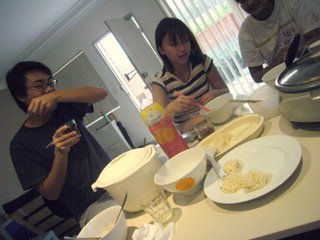Nak Ji bo Kum
"AhnYoOng-ha-sa-yoO"~ yes...my spoken Korean has been improving *proud grin* I took a brief break from cramming my lecture notes for a small dinner party last night. I put 3 willing+eager UNSW students to the true "Malaysian test" -- "How spicy do you like it?" Us Malaysian youngsters have a relationship with spicy food; from the usual spicy red chilies, curries, sambals and our favorite killer-hot birdseye chilies; but Koreans;......they take spicy to a whole different level.
I took a brief break from cramming my lecture notes for a small dinner party last night. I put 3 willing+eager UNSW students to the true "Malaysian test" -- "How spicy do you like it?" Us Malaysian youngsters have a relationship with spicy food; from the usual spicy red chilies, curries, sambals and our favorite killer-hot birdseye chilies; but Koreans;......they take spicy to a whole different level.

 You can tell it's heaps of 'fun' when the tissue box is pulled out and the sound of giggles, sniffles and slurps fill the table. Suffering with joy...I would say. *laughs* I don't mean to torture my guests...but COme-On~ just look how much they're enjoying themselves! *grin* I didn't want to be the party-pooper holding back on the chilli powder. *wink*.
You can tell it's heaps of 'fun' when the tissue box is pulled out and the sound of giggles, sniffles and slurps fill the table. Suffering with joy...I would say. *laughs* I don't mean to torture my guests...but COme-On~ just look how much they're enjoying themselves! *grin* I didn't want to be the party-pooper holding back on the chilli powder. *wink*.  Qimyi + the 2 housemates of very Indian roots (Pinky+ Amrit) were 'A-o-kay'. Pretty lil Amanda, "Viking" and I had a slight struggle with the sniffles...but I would do it all again just for another scoop of that fiery-hot broth. *MmmmMmm*...
Qimyi + the 2 housemates of very Indian roots (Pinky+ Amrit) were 'A-o-kay'. Pretty lil Amanda, "Viking" and I had a slight struggle with the sniffles...but I would do it all again just for another scoop of that fiery-hot broth. *MmmmMmm*...
I remember the question "What are we having?" being continuously repeated through the evening. I was consistently replying; "Nak ji Bo Kum" but I guess it was hard for everyone to register/comprehend what those four strange sounding syllables were. I finally gave up with a lazy answer I made up in English: "Spicy octopus-thing". I honestly didn't have a clue what Nak ji bo kum meant myself... well..not until I checked it out online this morning *grin*
Nakji Bokum is a very spicy octopus dish enjoyed by many Koreans. Octopus tentacles are cut into bite-sized pieces then pan stir-fried with spicy kochujang paste along with chili powder, sesame oil, red or green chili peppers, green onions, carrots and onions. Different variation of this dish do exist as the octopus can be substituted with squid for less chewy texture and taste. Non-Koreans may find this dish too spicy even diluted with rice that accompanies this dish. (www.trifood.com)
 Here's the recipe for those interested in having a go at this devilishly hot dish. Having it with a bunch of friends is so much more enjoyable...reminds me of noisy Chinese hot-pot nights. I do however feel a need to add a tiny warning to those who share bunks/roommates ... digestion of excessive spicy food often creates an unwanted amount of gas during the night *blush* :P
Here's the recipe for those interested in having a go at this devilishly hot dish. Having it with a bunch of friends is so much more enjoyable...reminds me of noisy Chinese hot-pot nights. I do however feel a need to add a tiny warning to those who share bunks/roommates ... digestion of excessive spicy food often creates an unwanted amount of gas during the night *blush* :P
 1lb octopus defrosted
1lb octopus defrosted1/2 lb frozen tiger prawns
2 onions chopped into thin rings
1 carrot sliced into thin strips (Use a grater for beautiful carrot curls)
1 large pack Golden enoki mushrooms
1 bowl sugar snap peas
1 pack korean rice cake (sticks)
3 stalks mint leaves plucked
2 stalks coriander leaves roughly chopped
1 slab asian fish-cake diced into fairly thin pieces
1-2 tbsp sesame oil for stir-frying
 Mix all ingredients and combine with washed octopus. Leave to marinade for at least 30 minutes to an hour.
Mix all ingredients and combine with washed octopus. Leave to marinade for at least 30 minutes to an hour. I gently blanched and cooked the noodles in boiling anchovies+ garlic stock earlier that evening; ran the strands through cold water and made small noodle servings to go with the spicy octopus broth. I personally prefer having it with noodles...but the boys seemed to like the rice with it too. This dish eaten with Rice is refered to in Korean as "Nak Ji Bo Kum Bop"
I gently blanched and cooked the noodles in boiling anchovies+ garlic stock earlier that evening; ran the strands through cold water and made small noodle servings to go with the spicy octopus broth. I personally prefer having it with noodles...but the boys seemed to like the rice with it too. This dish eaten with Rice is refered to in Korean as "Nak Ji Bo Kum Bop" Thanks everyone for coming over for dinner...it was a lots of fun, for me at least; I bet it was too for those who've already finished their exams~ *grrr*...I still have that last paper in the morning tomorrow; and it's off to Melbourne for me~~ CANt WAit!! *excitedly skips around the room*
Thanks everyone for coming over for dinner...it was a lots of fun, for me at least; I bet it was too for those who've already finished their exams~ *grrr*...I still have that last paper in the morning tomorrow; and it's off to Melbourne for me~~ CANt WAit!! *excitedly skips around the room*Tags: nak ji bo kum seafood stew octopus prawn budget recipe



















